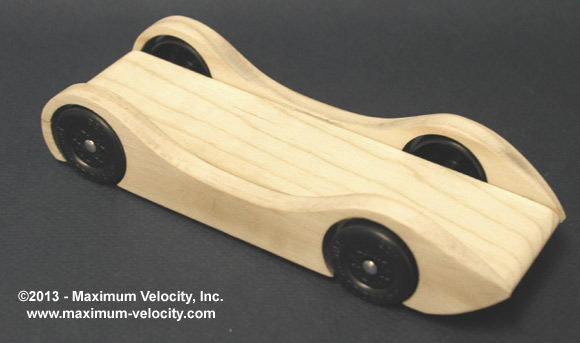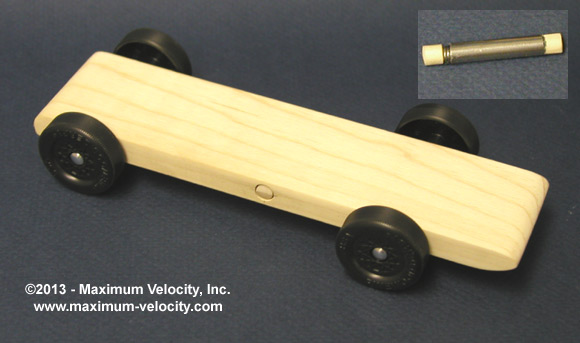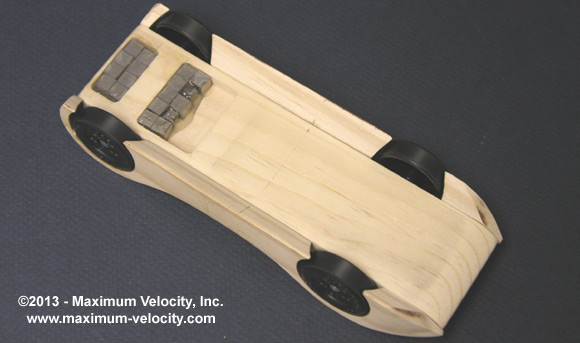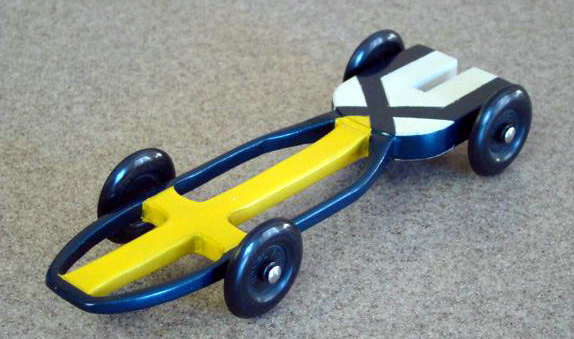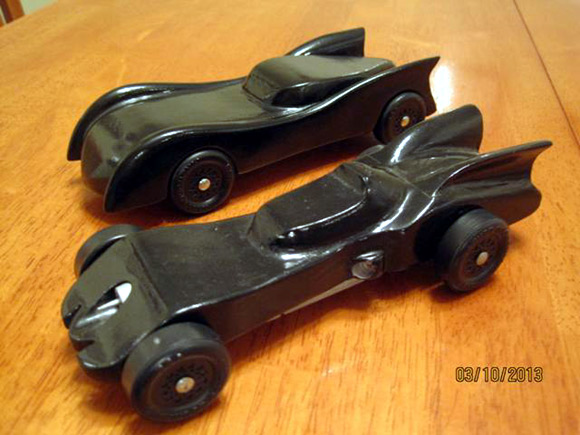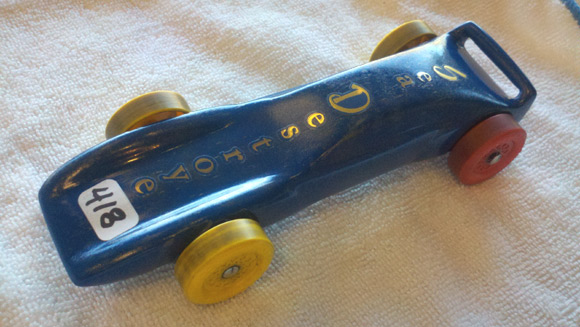– Feature Article – Cover Up Those Wheels With Fenders
– Pinewood Derby Car Showcase
– Q&A
Feature Article
Cover Up Those Wheels With Fenders
By Randy Davis
Looking at photos of pinewood derby cars in races across the country, especially the highly competitive league races, virtually every car has some kind of fenders. The intent of the fenders is to improve air flow over the wheels, squeezing out a few milliseconds. Given the slow speeds of pinewood derby cars, a few milliseconds is all you can hope for, but of course a few milliseconds is all it takes to win or lose a race.
But do fenders really help? Well, there is only one way to find out. So let’s do an experiment.
Factors to Control
In order to make sure that the presence or absence of fenders is actually being measured, we must construct a car on which:
- Fenders can be added and removed without affecting the wheels, axles, lubrication, and alignment.
- Ballast weight can be added and removed to compensate for the weight of the fenders, again without affecting any other factor.
- The ballast weight is added/removed at the center of gravity of the fenders.1
The Test Car
My solution to meet these criteria was to use full fenders and mount a 1/4 inch dowel pin at the center of gravity of the fender. A hole was then drilled through the car at the center of gravity of the fenders. This hole would accept the fender pin or the ballast weight.
Figure 1 – Test Car With Fenders
Figure 2- Test Car Without Fenders (Ballast Weight Shown as Inset)
Figure 3 – Underside of CarThe fenders were shaped by tapering the leading edge, and by beveling the portion that hangs below the car (this must be done to prevent scraping on the track guide rail – see Figure 3). The COG of the fender was located and a 1/4 inch hole was drilled at that location. Short pieces of 1/4 inch dowel pin were then glued into the fender hole.
The ballast weight was a bit of a challenge as I only had a 1-3/4 inch long x 1/4 inch diameter hole in which to put the weight. I ended up acquiring a 1/4 inch rod of solid tungsten and then cutting it to length (not a practice I recommend). I then super-glued two tungsten disks and two short pieces of dowel pin to the tungsten rod, resulting in a solid unit that was 1-3/4 inches long and just slightly less than the weight of the fenders. To adjust the weight, I sanded off a portion of the dowel pin attached to the fenders, resulting in an exact weight match.
The car body was made with a 1/4 inch hole drilled from side to side at the location of the fender COG. Weight pockets were added, and the car was brought up to five ounces (when the fenders are attached or the ballast weight is inserted). Packing tape was applied over the underbody pockets so that they did not affect air flow. The car was equipped with a raised front left wheel.
Other static car factors include:
- Pro-Stock Speed Wheels
- BSA Speed Axles (polished)
- Krytox 100 lubricant
- Down-canted front right wheel for rail-rider alignment
The Test
The car was assembled with the fenders; two adhesive dots were applied on the inside of each fender to keep it in the proper position. The alignment was set to drift left five inches over eight feet, which works well on my track. After a few trial runs, the testing commenced.
First, four runs were made with the fenders in place. Then the fenders were removed, the ballast weight added, and the alignment verified (no change needed). Eight runs were then made without fenders. Finally, the ballast weight was removed, the fenders re-installed, and the alignment re-checked (again, no change needed). An additional four runs were then made.
The high and low results were then removed for the fender heat times and the non-fender heat times. The remaining data was averaged and the standard deviation calculated.
The Results
To my surprise the results were clear2:
Fender Heat Average – 2.531
Standard Deviation – .00146
No-Fender Heat Average – 2.536
Standard Deviation – .00163
So on average, fenders improved the speed of the car by .005 seconds, and slightly reduced the variance in the heats.
The Tradeoff
One thing that needs to be pointed out is that fenders add weight to the car, and not at the desired location (the fenders in this test weighed 0.66 ounces). So, the question must be asked: Would the same improvement be seen if the weight was put at the back of the car and the fenders eliminated? Unfortunately, I did not set up the car to specifically test this, but I did tape the ballast weight on top of the car just in front of the rear axles. The heat times did improve to 2.533. But this test is not conclusive as the weight was not necessarily optimally placed and it was not inside the car.
But the point is that for best results the effect of the fender weight must be minimized. There are several ways to do this:
- Use half fenders instead of full fenders.
- Use balsa fenders instead of basswood or pine fenders.3
- Minimize the weight of the main car body as much as possible.
Conclusion
In a tight race, if implemented properly, fenders can give your car a slight edge. So, on your next project, consider covering up those wheels.
1For the purist, the ballast weight should really be spread all along the side of the car, but that would be extremely difficult to do.
2Actually to my relief. I was concerned that the data would be inconclusive and I would need to try again with half fenders. Half fenders would be more of a challenge to get the correct weight when the fenders were removed.
3I am not a big fan of balsa as it is more difficult to use, but it is very popular for fenders. Both pine and balsa half fenders are available from Maximum Velocity.
Pinewood Derby Car Showcase
Church Cross Car – Jim White and Aaron Shain
My grandson and I built this RA pinewood derby car for my son-in-law (grandson’s father). We call it the “Church Cross Car” for obvious reasons.
Batmobiles – Craig Look
Here are Evan and Jacob’s batmobiles. Evan’s batmobile is the open- wheeled version, while Jacob’s is the one with the fenders.
Sea Destroyer – Keith, Victoria, and Gabriel D.
Last year (2012) my son Gabriel won his pack race. But when he went to the district race, reality set in and he found out that he was not even close to being competitive. Walking out of the race, my son and I were discussing next year’s (2013) car and we decided to do everything that we could do to make his car the fastest it could be. This year (2013) my son won his pack race again and was able to compete in the district race. Overall he had the 5th best time of the 37 cars in his district. He was very happy with his finish. Thank you for helping make my son’s last race a great and happy experience for him.
Q&A
I am an inspector at our race, which requires four wheels on the ground. At the last race, four cars were broke trying to bend the axle down to meet this rule. Is there anything we can do to minimize damage when trying to fix a car to meet the four on the ground rule?
You might try tightly holding a Pro-Axle Guide against the car body/axle while bending. This will give the wood support and minimize the risk of breakage.
Another thing you can do is use the paper test for four on the ground. It is very difficult to get all four wheels perfectly down – usually one wheel is slightly up. If you slide a piece of paper under the up wheel and the wheel rolls with the paper, then the wheel can be considered to be on the ground. If the wheel doesn’t roll, then the wheel is up. This test is used by lots of packs to gauge whether a car is a three or four wheeler.
I am building a pinewood derby car, and must use a stock PineCar kit with the solid axles. I see your PineCar Speed Wheels, but no prepped solid axles. Do you offer any such animal? I was thinking a simple wedge design with short slot to the back, and tungsten weights to set the balance point at 1-1/8 inch in front of the rear axle. I’m open to all suggestions!! Bake block first? Any paint better than another? How about front nose shape and height?
Let me try to answer your questions in order.
- We do not have prepped solid axles. However, if they are allowed by your rules the PineCar Speed Wheels will give you a big bang.
- If possible, I would set the balance point at 1 inch or less. 1-1/8 inches is conservative. You would get more speed with a more aggressive balance point.
- Baking the block is not really helpful unless the block seems especially heavy or damp (not typical for PineCar blocks).
- Regarding paint, for brush painting use acrylic paints applied with a foam brush). For spray painting, use laquer paints such as “Duplicolor” from auto stores. Avoid enamel paints.
- Regarding the shape of the wedge, keep the profile as low as you can: 7/8 inch max at the back, better at 3/4 inch. Round down the nose.
- Make sure to thoroughly lube with a high-quality graphite, such as our Max-V-Lube or PineCar Hob-E-Lube. Avoid “Dry-White” and PineCar “XLR”.
- Check the width of the block. With the rod axles, oftentimes the body is too wide and the wheels do not spin freely. You may need to sand the side of the car body to get clearance between the wheel hub and car body on both sides. Alternately, cut the long rod axle in half so you can set the clearance of each wheel independently.
Want Answers?
Do you have a pinewood derby-related question? If so, e-mail us your question.We answer all questions by e-mail, but not every question will appear in the Q&A section of the newsletter.
Back Issues
Are you a new subscriber, or have you missed some of the previous newsletters? Don’t miss out; all of the issues for Volume 5 through Volume 17 are posted on our web site.
Newsletter Contributions
We welcome your contributions. If you would like to contribute an article, a web site review, a speed tip, or a pinewood derby memory, please e-mail us.
Subscription Information
The Pinewood Derby Times is a free e-newsletter focused on pinewood derby racing. It is published biweekly from October through March.
If you haven’t already done so, please forward this issue to your pinewood derby friends. But please don’t subscribe your friends. Let them decide for themselves. Thanks.
If this newsletter was forwarded to you, why not subscribe to receive this newsletter. There is no cost, and your e-mail address is safe, as we never sell or share our distribution list.
To subscribe, send a blank e-mail to
[email protected]
You will receive a confirmation e-mail. Reply to the confirmation e-mail and you will start receiving the Pinewood Derby Times with the next issue.
Randy Davis, Editor, Pinewood Derby Times
E-Mail: [email protected]
(C)2018, Maximum Velocity, Inc. All rights reserved. Please do not reprint or place this newsletter on your web site without explicit permission. However, if you like this newsletter we grant permission, and encourage you to e-mail it to a friend.
Maximum Velocity disclaims any personal loss or liability caused by utilization of any information presented in this newsletter.
The Pinewood Derby Times is not specific to, and is not affiliated with the Boy Scouts of America, YMCA, Awana, or any other organization.
(R)Maximum Velocity is a registered trademark of Maximum Velocity, Inc.
(R)Pinewood Derby is a registered trademarks of the Boys Scouts of America.
(R)Awana is a registered trademark of Awana Clubs International.
All other names are trademarks of their respective owners.

